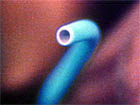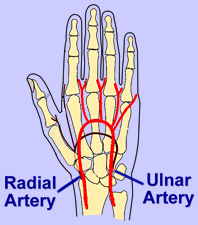The
Body's Highway
Interventional medicine, or catheter-based therapy, utilizes the body's circulatory
system as a "highway" -- and avoids open surgery by threading catheters
into arteries and delivering medicine and devices to the affected areas from
the "inside-out".
This highway can be accessed by several "on-ramps":
the femoral artery in the groin, the radial artery in the
wrist and the brachial artery in the elbow. |
|

hollow catheter
tip |
The Femoral (Groin) Approach
When
attempting to access the coronary arteries to clear a blockage
with a balloon, or place a stent
to hold the artery open, the most often used entry point to the
circulatory system has been the femoral artery. A small puncture
is made with a hollow needle, which then allows a long tube, called
a catheter, to be threaded
into the femoral artery, up and around the aorta and into the
coronary arteries. This femoral approach, sometimes
called the Judkins technique (after Dr.
Melvin Judkins who invented it in the 1960's) is
the standard way in which most catheter-based procedures are
done
in
the U.S.
However, there are some limitations to the femoral
approach. The femoral or nearby arteries may be diseased
and will
not allow
a catheter to pass easily. Sometimes a patient is overweight or
obese, and the femoral artery is buried deep underneath the fatty
tissue, making it hard to access, and then equally hard to compress
after the procedure -- a necessary step in stopping the bleeding.
In some cases, bleeding that is not immediately visible to the
eye can occur in a backwards fashion into the body cavity -- this
can be seen as a discoloration, like a bruise, that expands and
must be treated. The possibility of involvement of the femoral
nerve also exists. These types of complications are small
in number, often quoted at 3%.
Invention of the Radial Technique
In the late 1980's,
a French-Canadian physician, Dr. Lucien Campeau, started
using
the
right radial
artery, which is located in the
wrist,
as
an entry
point for diagnostic catheterizations. While the radial artery
is slightly smaller than the femoral, it is still large enough
to
allow most
catheters
to
traverse
the
distance to the coronary anatomy. In fact the radial artery was
initially harvested and used in coronary artery bypass grafts.
By 1992 a group in Amsterdam, headed
by Dr. Ferdinand Kiemeneij, had begun exploring ways to use the
radial artery for interventional procedures, such as delivering
balloons and stents. They were somewhat limited by the early equipment,
but as catheters and stents became lower profile, thinner and easier
to manipulate, the ability of physicians to use the radial artery
increased. Most devices today can be delivered successfully using
the radial artery.
Advantages of the Radial Approach
Most of the disadvantages of the femoral technique are nonexistent
in the radial, also called the transradial approach. Even in
obese patients, the radial artery is close to the skin surface,
making
the initial
needle
puncture
simple
and straight-forward. For the same reason, when the procedure
has been completed, a short compression of the radial artery
can stop the bleeding (achieve hemostasis) -- even when the patient
has been aggressively anticoagulated with medicines to
keep blood clots from forming, more and more common in the modern
cath lab. Should any bleeding occur, it can be seen immediately.
Finally, unlike
the
proximity
of
the
femoral
artery
to the femoral
nerve,
the
radial artery is not close to a major nerve, so the likelihood
of "nicking"
a nerve
during
the procedure is very low.
While complications are less common with
the radial technique, the advantage experienced by all radial patients
is that there is no longer any need to lie
flat and still for 4-6 hours,
or to
experience
what
is sometimes a painful manual compression of the artery to curb
the bleeding. Patients leave the catheterization lab and are able
to sit up and walk almost immediately. Because of the simpler healing
process for the arterial puncture in the wrist, certain patients
may also be discharged home without having to spend the night.
The progress in the treatment of coronary artery
disease has evolved to the point that when you compare heart bypass
surgery from two decades ago with stenting done today via the
transradial approach, what was a 4 hour major open heart operation,
with general anesthesia,
a week or more in
the hospital
and
months
of
recovery, can now in some cases be performed as an outpatient procedure.
Is the Radial Approach for Everyone?
There are a few prerequisites for patients to be a candidate
for the transradial approach.
The first
is confirmation of a dual, or "protected",
blood supply to the hand. The radial artery loops around the hand and joins
the ulnar artery. Both arteries supply blood to the hand and fingers. It is
precisely this dual blood supply that makes the radial technique safe. Should
the radial artery close up (a complication seen in a small percentage of cases)
the clinical result tends to be benign, because the ulnar artery continues
to function.
The first step a cardiologist takes in deciding
on the radial approach is an Allen test to assess that both radial
and ulnar arteries are
functioning normally -- a simple test that can be done by compressing
the arteries
by
hand at bedside or in the doctor's office. If they are not normal,
then the femoral approach is preferred. Some other contraindications
exist,
such as
the
need to use
larger
devices during the angioplasty, pre-existing bypass grafts
in certain areas
or tortuous vessels that may prevent the catheter from
navigating
to the coronaries from the arm. About 30-40% of patients are not
candidates for radial access. |
|
 |
While the complication rate with the radial approach
is extremely low, there is always some risk with any medical procedure.
It is important
for patients to discuss the risks
and benefits of the femoral vs. radial approaches, as these can
vary for each individual.
Limited Utilization in the United States
The more frequent reason that patients are not offered the radial
approach is that only a relatively small percentage of interventional
cardiologists in the U.S. are trained in the technique. Parts of
Europe and Japan do 40% or more of their cases using the radial
artery, but in the U.S. estimates are in the low single digits
-- although
those U.S. cardiologists and radiologists who have learned the
radial technique tend to use it for many, if not most, of their
patients.
The reasons for this low penetration are several:
lack of economic incentive due to the reimbursement structure,
lack of patient awareness that this alternative exists, and lack
of trained cardiologists.
The situation, however, is changing. More
and more practices are beginning to see the advantages in lower
complication rates, increased patient satisfaction and even cost-savings
(complications can be expensive to manage).
The femoral approach
has been the gold standard for many years. Moving to the newer
radial technique requires specialized training and advanced skills.
Training opportunities are increasing as computer simulation
models are being
developed
and a number of hospitals, both in and outside of the U.S. are
now offering programs and mentorships. Current signs point to the
increasing
use of the radial technique
in the
U.S.
For the latest information on developments in
the transradial technique, interviews with experienced practitioners
and a list of training opportunities, visit our Radial
Access Center.
|



